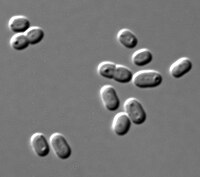Synechococcus
| Synechococcus | |
|---|---|
 |
|
| Synechococcus PCC 7002 cells in DIC microscopy | |
| Scientific classification | |
| Kingdom: | Bacteria |
| Phylum: | Cyanobacteria |
| Order: | Synechococcales |
| Family: | Synechococcaceae |
| Genus: |
Synechococcus Nägeli, 1849 |
| Species | |
|
See text |
|
See text
Synechococcus (from the Greek synechos, in succession, and the Greek kokkos, granule) is a unicellular cyanobacterium that is very widespread in the marine environment. Its size varies from 0.8 to 1.5 µm. The photosynthetic coccoid cells are preferentially found in well–lit surface waters where it can be very abundant (generally 1,000 to 200,000 cells per ml). Many freshwater species of Synechococcus have also been described.
The genome of S. elongatus strain PCC7002 has a size of 3008047 bp, whereas the oceanic strain WH8102 has a genome of size 2.4 Mbp.
Synechococcus is one of the most important components of the prokaryotic autotrophic picoplankton in the temperate to tropical oceans. The genus was first described in 1979, and was originally defined to include "small unicellular cyanobacteria with ovoid to cylindrical cells that reproduce by binary traverse fission in a single plane and lack sheaths". This definition of the genus Synechococcus contained organisms of considerable genetic diversity and was later subdivided into subgroups based on the presence of the accessory pigment phycoerythrin. The marine forms of Synechococcus are coccoid cells between 0.6 and 1.6 µm in size. They are Gram-negative cells with highly structured cell walls that may contain projections on their surface. Electron microscopy frequently reveals the presence of phosphate inclusions, glycogen granules, and more importantly, highly structured carboxysomes.
Cells are known to be motile by a gliding method and a novel uncharacterized, nonphototactic swimming method that does not involve flagellar motion. While some cyanobacteria are capable of photoheterotrophic or even chemoheterotrophic growth, all marine Synechococcus strains appear to be obligate photoautotrophs that are capable of supporting their nitrogen requirements using nitrate, ammonia, or in some cases urea as a sole nitrogen source. Marine Synechococcus species are traditionally not thought to fix nitrogen.
...
Wikipedia
